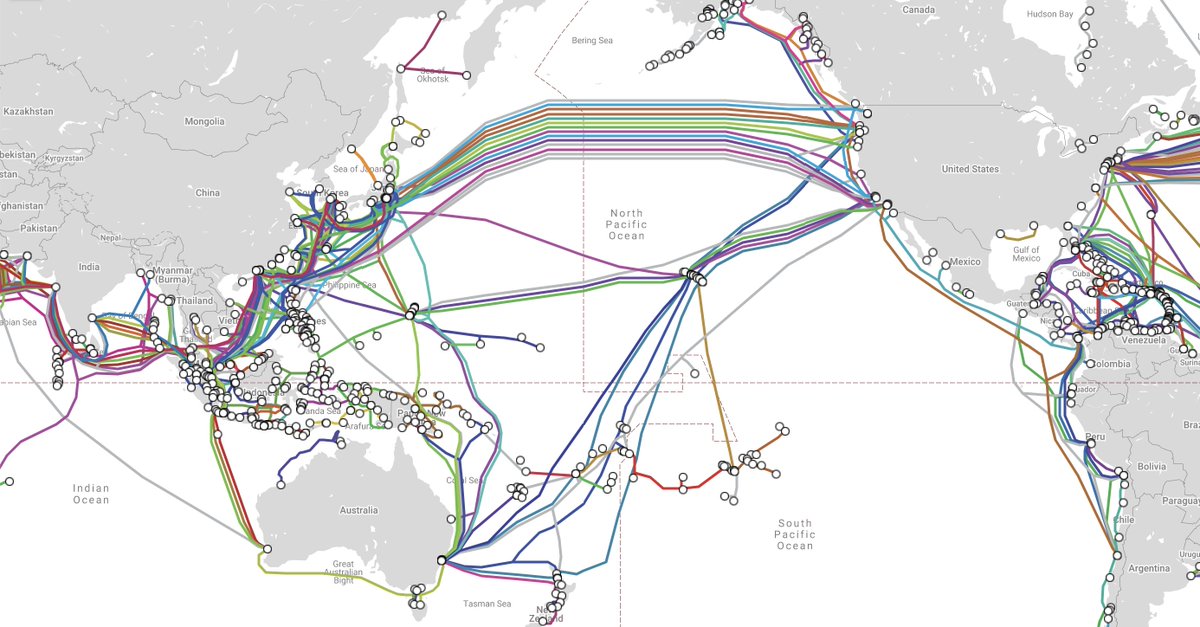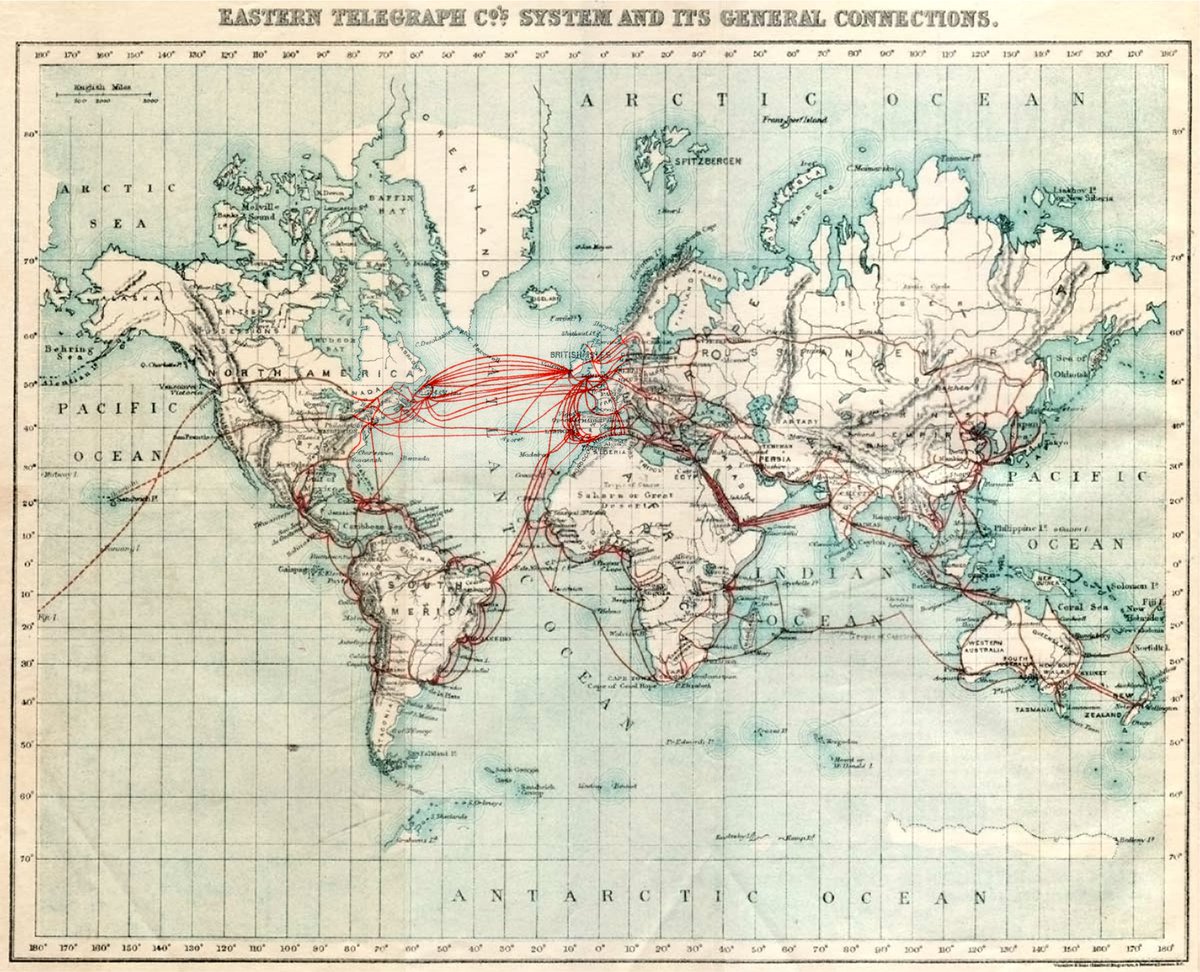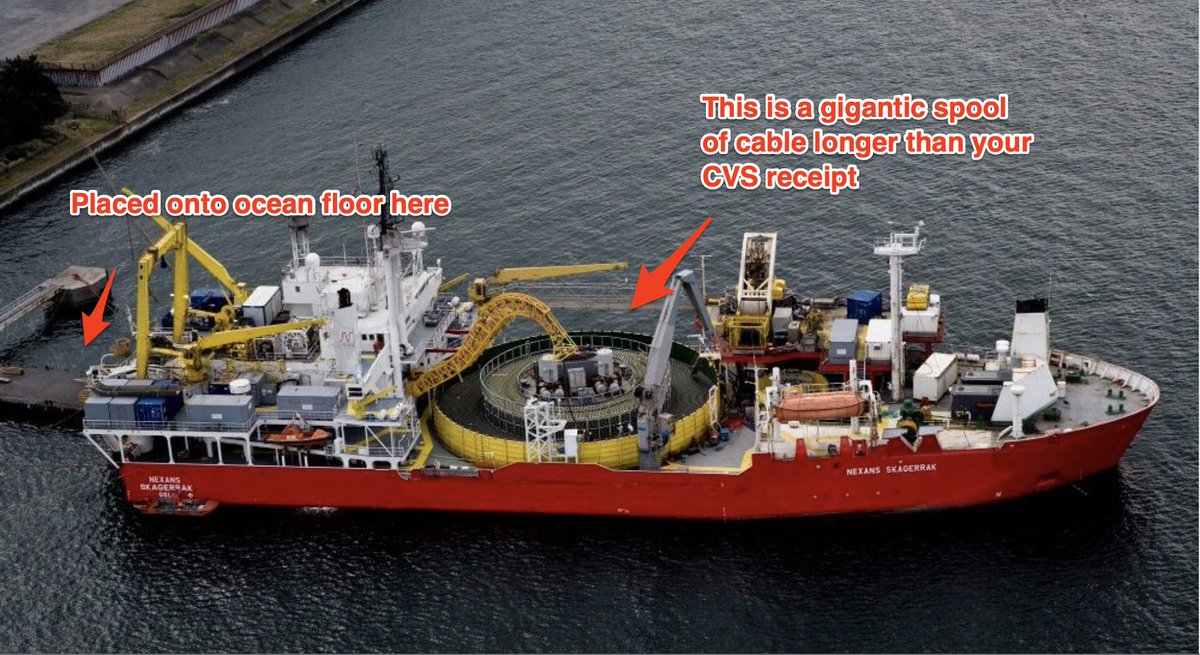I'm in Hawaii, and every time I get on a Zoom call I can't help but be in awe that I can have real-time conversations on an island to anywhere in the world Here's a ... dive  into how undersea cables connect the earth to deliver low latency anywhere
into how undersea cables connect the earth to deliver low latency anywhere 

 into how undersea cables connect the earth to deliver low latency anywhere
into how undersea cables connect the earth to deliver low latency anywhere 

Intuitively, we've wanted to lay cables across waters since we invented cables. The dream then was to lay one gigantic one from London to New York connecting telegraph infrastructure; an enormous feat for which the technology nor the cable (3,500mi+) existed at the time
In 1842 Sam Morse (inventor of single wire telegraph & progenitor of Morse Code) coated with rubber and successfully operated an undersea cable experiment under the New York Harbor 

The first commercial undersea cable was laid in 1851 across the English Channel connecting England to France. Even well before WWI, undersea cables were seen to be highly strategic: your comms were secure as they were not being broadcast over airwaves where anyone could listen
This exploded interest in wiring USA to UK. The first expedition to connect both sides of the Atlantic began in 1854 and was completed in 1858. Operation commenced with a msg sent from Queen Victoria to President Buchanan, but signal quality quickly degraded to uselessness
With this first cable (until it was rendered useless), it would take two minutes to send ONE character via Morse code. Incredible to compare that to that one friend  (me) who sends you 100 iMessages in 2 minutes today
(me) who sends you 100 iMessages in 2 minutes today
 (me) who sends you 100 iMessages in 2 minutes today
(me) who sends you 100 iMessages in 2 minutes today
After several more attempts, in 1866 we finally had an active undersea cable across the Atlantic. The impact of this cannot be understated. Before this, messages would be sent by ship and in bad weather could take weeks to deliver. Now, US and UK could send and reply SAME-DAY
Furthermore, think of what the development of undersea cables did for globalization, sharing news and building more efficient markets around more reliable pricing data
Back to strategic importance, the UK accelerated development of cables to disparate parts of its Empire over the next 20 years; connecting to Mumbai through Saudi Arabia and by undersea cable to Cape Town, ensuring uninterrupted access. Learn more here: https://en.wikipedia.org/wiki/All_Red_Line
An incredible map of what the British (public & private enterprise) had accomplished by 1901. Considerable populations of the world have same-day communications to other corners of the world strengthening trade, security and governmental administration. 110s of 2nd order effects
These undersea cables played an interesting role in WWI-- I'll let a true historian weigh in on the impact-- in 1914 after war was declared the British CUT German undersea cables, essentially disconnecting Germany from the world by cable. Learn more here: https://www.bbc.com/news/world-europe-42367551
Likely one of the first major acts of information warfare; a brilliant move strategically to strengthen Britain's existing advantages on coordination within their massive global empire. But I disgress...
FF to telephony, although invented in the late 19th century with over 10m Bell system users in 1918, the first TATL telephone cable, TAT-1 was only laid in 1956 and supported 36 concurrent calls. (Although in 1927 it was possible to call London from NYC through radio waves, $$$$)
In 1963 TAT-1 would carry the infamous Moscow-Washington "red phone"* hotline, after the Cuban Missile Crisis  demonstrated the importance of not sending highly-time sensitive comms over telegraph requiring 12+hrs sending and decoding https://en.wikipedia.org/wiki/Moscow%E2%80%93Washington_hotline
demonstrated the importance of not sending highly-time sensitive comms over telegraph requiring 12+hrs sending and decoding https://en.wikipedia.org/wiki/Moscow%E2%80%93Washington_hotline
 demonstrated the importance of not sending highly-time sensitive comms over telegraph requiring 12+hrs sending and decoding https://en.wikipedia.org/wiki/Moscow%E2%80%93Washington_hotline
demonstrated the importance of not sending highly-time sensitive comms over telegraph requiring 12+hrs sending and decoding https://en.wikipedia.org/wiki/Moscow%E2%80%93Washington_hotline
Fun fact: The first message sent from Washington to Moscow over TAT-1 was "THE QUICK BROWN FOX JUMPED OVER THE LAZY DOG's BACK 0123456789"
Aside: If you get stressed waiting for your date to reply about your Zoom dinner plans, imagine JFK's stress waiting for Khrushchev to reply to "u up"
As with the first telegraph cables, the success of TAT-1 led to an explosion of interest, demand and construction of undersea telephony cables globally, a number of them increasing bandwidth between US and Europe
FF again to the 1980s, we developed fiber optic cables and deployed TAT-8 across the Atlantic. It carried 280 M*bits*/sec over the Atlantic, and due to numerous telephone advances, could carry 40,000 telephone circuits. Capacity was reached in just 18 months; they assumed decades
As the early internet takes form, IBM finances a T-1 line (1.5Mbps, a high bandwidth line designed by Bell Labs) on TAT-8 from @Cornell to @CERN. @timberners_lee would use this as a part of the early World Wide Web demonstrations 

TAT-9 was launched in 1992 with a theoretical speed of 560 Mbits per sec. Like the JFK<>LHR air corridor is one of the most profitable in the world (maybe not during covid  ), most of the innovation in undersea cables happened across the Atlantic, and then copied globally.
), most of the innovation in undersea cables happened across the Atlantic, and then copied globally.
 ), most of the innovation in undersea cables happened across the Atlantic, and then copied globally.
), most of the innovation in undersea cables happened across the Atlantic, and then copied globally.
The development of these cables closely follow the development of information markets growing economies-- between 1998 and 2003, ~70% of undersea fiber-optic cable was laid in the Pacific to better connect to rapidly growing Asian markets
This approach has come at the cost of equity-- until recently Sub-Saharan Africa has been at a severe disadvantage in benefitting from the growth of benefitting from the Internet since their internet infrastructure was slower as a lack of undersea cable infra. ar es Salaam
New undersea cables to Cape Town, Lagos, Luanda and Dar es Salaam are changing this https://www.submarinenetworks.com/en/africa
Wrapping this up-- I take the immense scale of our internet infrastructure for granted-- these cables were laid one mile at a time on the ocean floor by huge ships like this to enable pings across the internet at millisecond speeds.
& one of my favorite websites showing a map of all cables https://www.submarinecablemap.com/

 Read on Twitter
Read on Twitter





